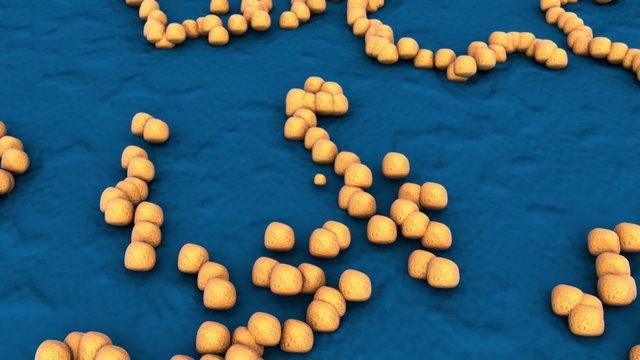Taxonomy and Classification
Streptococcus belongs to the family Streptococcaceae within the order Lactobacillales. The genus comprises over 110 recognized species and subspecies, a number that continues to rise with advancements in sequencing technologies. Streptococci are classified based on various criteria:
- –
Hemolytic Properties:
- –Alpha-hemolytic: Partial hemolysis, producing a greenish discoloration on blood agar. Notable species include Streptococcus pneumoniae.
- –Beta-hemolytic: Complete hemolysis, resulting in clear zones around colonies. This group includes Streptococcus pyogenes and Streptococcus agalactiae.
- –Gamma-hemolytic: No hemolysis observed.
- –
Lancefield Grouping:
- –Developed by Rebecca Lancefield, this system classifies beta-hemolytic streptococci based on carbohydrate antigens in their cell walls. Groups are designated by letters A to V (excluding E, I, and J). For example, Streptococcus pyogenes is classified as Group A, while Streptococcus agalactiae is Group B.
Morphology and Physiology
Streptococci are Gram-positive cocci, typically less than 2 μm in diameter, that tend to form chains or pairs. They are non-motile, non-spore-forming, and catalase-negative. Most species are facultative anaerobes, capable of growth in both aerobic and anaerobic environments. Optimal growth occurs at 35-37°C on enriched media such as blood agar.
Pathogenicity and Clinical Significance
While many streptococcal species are part of the normal human microbiota, certain species are pathogenic:
- –
Streptococcus pyogenes (Group A Streptococcus):
- –Causes pharyngitis (strep throat), impetigo, scarlet fever, rheumatic fever, and invasive diseases like necrotizing fasciitis and streptococcal toxic shock syndrome.
- –Virulence factors include M protein, streptolysins, and hyaluronidase.
- –
Streptococcus agalactiae (Group B Streptococcus):
- –Leading cause of neonatal sepsis and meningitis.
- –Colonizes the gastrointestinal and female genital tracts; transmission to neonates can occur during birth.
- –
Streptococcus pneumoniae:
- –Major cause of community-acquired pneumonia, meningitis, otitis media, and sinusitis.
- –Encapsulated with over 100 different serotypes; the capsule serves as a primary virulence factor.
Virulence Factors
Streptococci possess various virulence factors that contribute to their pathogenicity:
- –
M Protein:
- –Found in S. pyogenes, it aids in adherence to host tissues and inhibits phagocytosis by binding to host complement regulators.
- –
Capsule:
- –Present in species like S. pneumoniae and S. agalactiae, the polysaccharide capsule prevents phagocytosis and enhances survival in the host.
- –
Enzymes and Toxins:
- –Streptolysins: Hemolysins produced by S. pyogenes that lyse red and white blood cells.
- –Hyaluronidase: Degrades hyaluronic acid in connective tissue, facilitating bacterial spread.
- –Erythrogenic Toxin: Produced by certain strains of S. pyogenes, causing the rash in scarlet fever.
Epidemiology and Transmission
Streptococcal infections are transmitted through respiratory droplets, direct contact with infected individuals, or, in the case of S. agalactiae, from mother to neonate during childbirth. Asymptomatic carriage is common, particularly for S. pneumoniae and S. pyogenes, serving as reservoirs for transmission.
Diagnosis and Treatment
Diagnosis involves:
- –Culture: Isolation on blood agar to observe hemolytic patterns.
- –Serological Tests: Lancefield grouping for beta-hemolytic streptococci.
- –Molecular Methods: PCR assays for rapid identification.
Treatment typically includes antibiotics such as penicillin. However, resistance is emerging in some species, necessitating susceptibility testing and alternative therapies when appropriate.
Prevention
Preventive measures include:
- –Vaccination: Pneumococcal vaccines for S. pneumoniae.
- –Screening: Pregnant women are screened for S. agalactiae colonization, with intrapartum antibiotic prophylaxis administered to prevent neonatal infection.
- –Hygiene Practices: Proper handwashing and respiratory etiquette to reduce transmission.
Research and Developments
Ongoing research focuses on:
- –Vaccine Development: Efforts to create effective vaccines against S. pyogenes and S. agalactiae.
- –Antimicrobial Resistance: Monitoring and understanding resistance patterns to inform treatment guidelines.
- –Pathogenesis Studies: Investigating virulence mechanisms to develop targeted therapies.
Streptococcus remains a significant genus in medical microbiology, with species ranging from commensals to formidable pathogens. Understanding their classification, virulence factors, and clinical implications is crucial for effective diagnosis, treatment, and prevention of streptococcal diseases.
